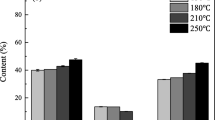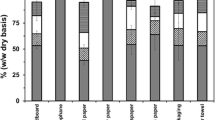Abstract
Enzymatic hydrolysis is one of the key steps in biofuel production from lignocellulosic material. High consistency of biomass slurry in the hydrolysis step improves the economics and energy efficiency of biofuel processes. However, it has been shown that the high consistency also decreases the hydrolysis yield and affects the rheology of hydrolysis slurry. In this study, mixing related effects on the hydrolysis of old corrugated cardboard have been studied in two different scales. Results from small pressure tube scale studies show that the dosing order of enzyme and substrate (16 % (w/v)) affect both hydrolysis rate and yield. The best result was achieved by the addition of all enzyme to dilute hydrolysis slurry with subsequent stepwise addition of the substrate (52.8 ± 1.2 % yield). The highest initial rate was achieved by adding the enzyme into the vessel before substrate. Further studies in a scale of a stirred-tank reactor showed that enzyme addition before substrate is advantageous mainly due to the mixing behavior of hydrolysis slurry at high substrate consistencies (>15 % (w/v)). The dosing of substrate before enzyme resulted in thick slurry that could not be kept in full motion within the first hours of hydrolysis. Full motion was reached by the dosing of the enzyme before substrate followed by the dosing of substrate within an hour after the enzyme. The effect of the dosing order on hydrolysis yield at high consistency in the studied reactor scale is negligible.







Similar content being viewed by others
References
Alvira P, Tomas-Pejo E, Ballesteros M, Negro MJ (2010) Pretreatment technologies for an efficient bioethanol production process based on enzymatic hydrolysis: a review. Bioresour Technol 101(13):4851–4861
Eriksson L, Johansson N, Kettaneh-Wold N, Wikstrom C and Wold S (2008) Design of experiments: principles and applications. Umetrics AB, Umeå
Fan Z, South C, Lyford K, Munsie J, van Walsum P, Lynd L (2003) Conversion of paper sludge to ethanol in a semicontinuous solids-fed reactor. Bioprocess Biosyst Eng 26(2):93–101
Ghose T (1987) Measurement of cellulase activities. Pure Appl Chem 59(2):257–268
Gupta R, Kumar S, Gomes J, Kuhad RC (2012) Kinetic study of batch and fed-batch enzymatic saccharification of pretreated substrate and subsequent fermentation to ethanol. Biotechnol Biofuels 5:16
Hodge DB, Karim MN, Schell DJ, McMillan JD (2009) Model-based fed-batch for high-solids enzymatic cellulose hydrolysis. Appl Biochem Biotechnol 152(1):88–107
Jorgensen H, Vibe-Pedersen J, Larsen J, Felby C (2007) Liquefaction of lignocellulose at high-solids concentrations. Biotechnol Bioeng 96(5):862–870
Kinnarinen T, Shakhanova M, Hietanen E, Salmimies R, Häkkinen A, Louhi-Kultanen M (2012) Effect of mixing on enzymatic hydrolysis of cardboard waste: saccharification yield and subsequent separation of the solid residue using a pressure filter. Bioresour Technol 110:405–411
Kristensen JB, Felby C, Jorgensen H (2009) Yield-determining factors in high-solids enzymatic hydrolysis of lignocellulose RID E-1728-2011. Biotechnol Biofuels 2:11
Kumar R, Wyman CE (2008) An improved method to directly estimate cellulase adsorption on biomass solids. Enzyme Microb Technol 42(5):426–433
Lu Y, Wang Y, Xu G, Chu J, Zhuang Y, Zhang S (2010) Influence of high solid concentration on enzymatic hydrolysis and fermentation of steam-exploded corn stover biomass. Appl Biochem Biotechnol 160(2):360–369
Modenbach AA, Nokes SE (2013) Enzymatic hydrolysis of biomass at high-solids loadings—a review. Biomass Bioenergy 56:526–544
Mohagheghi A, Tucker M, Grohmann K, Wyman C (1992) High solids simultaneous saccharification and fermentation of pretreated wheat straw to ethanol. Appl Biochem Biotechnol 33(2):67–81
Palmqvist B, Wiman M, Liden G (2011) Effect of mixing on enzymatic hydrolysis of steam-pretreated spruce: a quantitative analysis of conversion and power consumption. Biotechnology Biofuels 4:10
Rosgaard L, Andric P, Dam-Johansen K, Pedersen S, Meyer AS (2007) Effects of substrate loading on enzymatic hydrolysis and viscosity of pretreated barley straw. Appl Biochem Biotechnol 143(1):27–40
Ryu D, Mandels M (1980) Cellulases—biosynthesis and applications. Enzyme Microb Technol 2(2):91–102
Sluiter A, Hames B, Ruiz R, Scarlata C, Sluiter J, Templeton D, Crocker D (2008) Determination of structural carbohydrates and lignin in biomass. Laboratory Analytical Procedure (LAP), NREL/TP-510–42618, National Renewable Energy Laboratory. Golden, Colorado
Sluiter A, Hames B, Ruiz R, Scarlata C, Sluiter J, Templeton D (2008) Determination of ash in biomass. Laboratory analytical procedure (LAP), NREL/TP-510–42622, National Renewable Energy Laboratory. Golden, Colorado
Tengborg C, Galbe M, Zacchi G (2001) Influence of enzyme loading and physical parameters on the enzymatic hydrolysis of steam-pretreated softwood. Biotechnol Prog 17(1):110–117
Um B, Hanley TR (2008) High-solid enzymatic hydrolysis and fermentation of Solka Floc into ethanol. J Microbiol Biotechnol 18(7):1257–1265
Wang L, Templer R, Murphy RJ (2012) High-solids loading enzymatic hydrolysis of waste papers for biofuel production. Appl Energy 99:23–31
Acknowledgments
The authors are grateful to the Finnish Funding Agency for Technology and Innovation (TEKES) and Graduate School in Chemical Engineering (GSCE) of funding this research. Part of the research was done under the TEKES Research project no. 1428/31/2009, Intensification of bioprocess chains.
Author information
Authors and Affiliations
Corresponding author
Rights and permissions
About this article
Cite this article
Sotaniemi, VH., Tikkanen, T., Pasanen, A. et al. Effect of enzyme and substrate dosing strategies on mixing and hydrolysis of old corrugated cardboard. Biomass Conv. Bioref. 5, 141–148 (2015). https://doi.org/10.1007/s13399-014-0136-4
Received:
Revised:
Accepted:
Published:
Issue Date:
DOI: https://doi.org/10.1007/s13399-014-0136-4




